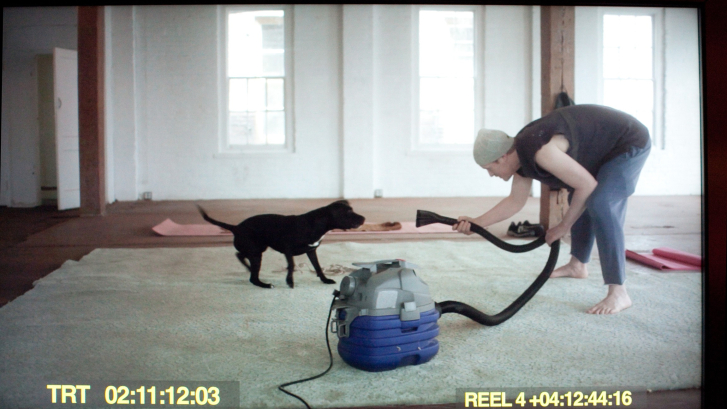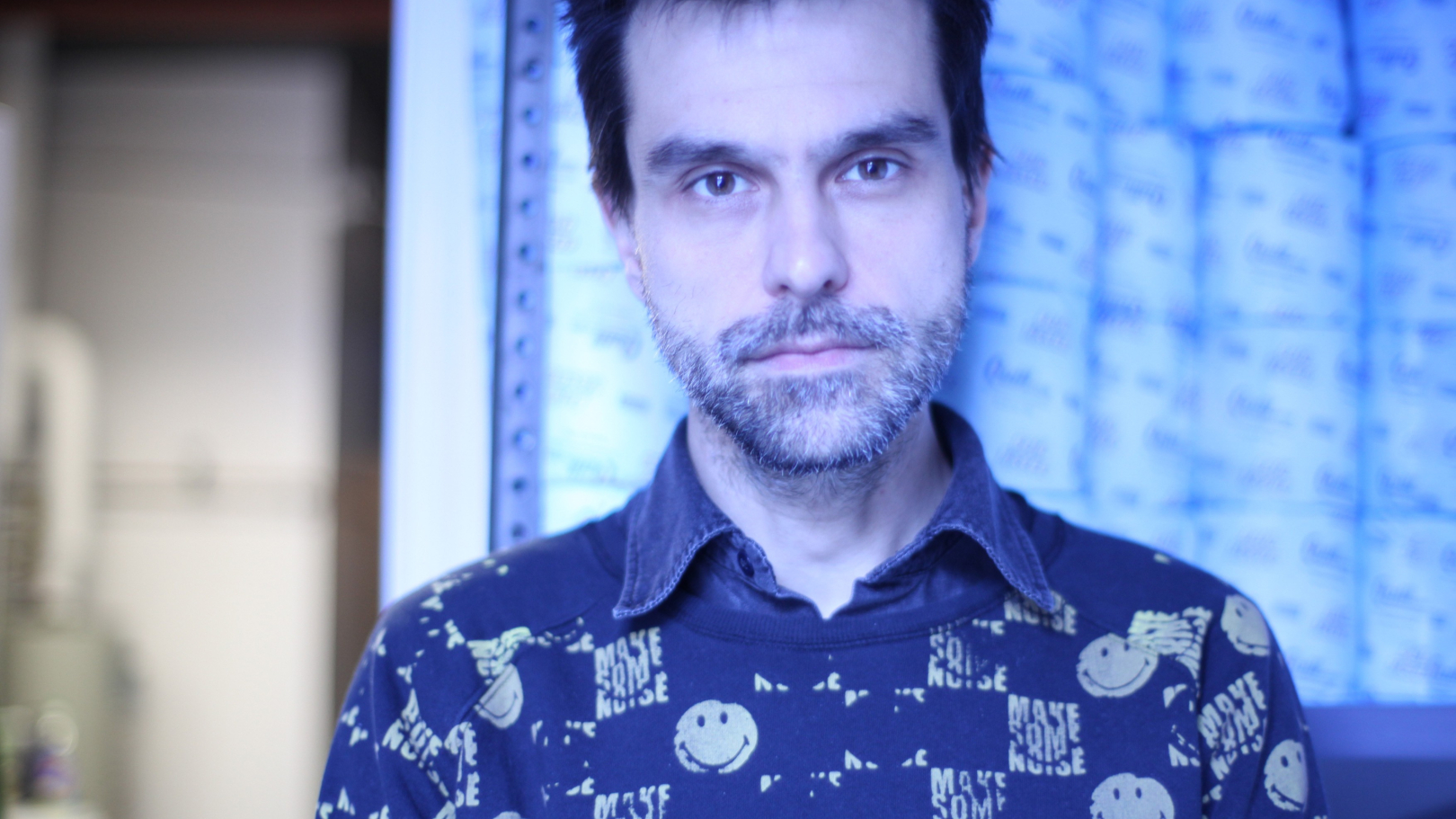Utopians

UTOPIANS recounts the origins of an unlikely family made up of three independent yet emotionally needy individuals: Roger, a struggling yoga teacher; Zoe, his headstrong Iraq veteran daughter; and Maya, Zoe’s reckless girlfriend.
Roger teaches yoga. The relationship with his daughter Zoe, who has just finished her military service, is put under strain by her love for Maya, a young woman who is allegedly a certified schizophrenic. There is tension with the participants of his yoga class when Roger repeatedly comes late and brings along a stray dog. When Roger, Zoe and Maya take on a renovation job on a middleclass home nothing goes to plan and the whole affair is wrought with tension.
Three people on the edge: of society, of control, of strength and of collapse. The different realities that Roger tries to get to grips with, metaphors for Maya’s schizophrenia catch up with him in his yoga class when his belief that “we can make our own time” reaches its limits just as fast as his “feel united with the world around you” notion clashes with social reality.
For his feature debut, Zbigniew Bzymek has found a form that is remote from social drama – the outline of a story is sketched in a non-dramatic and non-linear way by scenes that are sometimes separated by fades to black. With an idiosyncratic floating atmosphere and one of the most long-lasting guitar improvisations since DEAD MAN.
Hans-Joachim Fetzer
“Spirituality empties you out”
Two of the main actors in Utopians – Courtney Webster as Zoe and Lauren Hind as Maya – are also the producers of the film. How was that constellation established? Were you first looking for a cast for your completed script or did you develop the story together?
There is danger in having someone produce and act, it reflects the vanity project model – which we all know can signal artistic death. However, our production had one crucial difference – Lauren and Courtney are producer/actors but they didn’t raise the money. I raised most of it. Also they didn’t choose me, I chose them. This complex structure created a small, tightly knit group. We needed this structure since nobody was getting paid.
However, it’s a crazy spot to put someone in – to produce and to act. It creates an identity crisis. You can be pragmatic like this if people have both discipline and dynamism. At first I was working with Lauren and Courtney as producers. I knew I wanted to cast Courtney, but I wasn’t sure for which part. And then Robert Mleczko [the director of photography - Ed.] and I started photographing Lauren in the locations we were scouting…
As far as the origin of the script goes, I wrote the film for my sister and for Robert Walser and for the underground theater giant Jim Fletcher – who in my mind is the biggest actor in New York. Then I starved until he was available. I risked it and he came through.
The film tells the story of three characters – Roger, his daughter Zoe and her friend Maya – who are all on the verge of an emotional breakdown. It seems that Roger’s effort at spirituality are blocked by the reality that surrounds him, which makes him fail. What interested you in that development?
I love failure... as a topic, of course. When you fail, it means you once had a will and a plan... when you share failure, it’s like you’re passing a baton in a relay race to people who are sympathetic and understand you. It can be like saying: “Here are the tools, here is what I did; it didn’t work, you have a go at it, friend.” That’s what “experimental” means to me. It allows the viewer a forensic analysis of the death of a plan. However, it’s a very dangerous love affair. You have to have enough life in you – even after hanging out with corpses – to pick yourself up and not be defined by that failure. You have to trust people and make strong living allies. I think it’s very easy to cultivate spirituality in an atmosphere of failure – it can be like a cave, because it reduces you, empties you out, it can make you feel special or misunderstood if you still believe in your plan. This is also the road to delusion and megalomania, incidentally.
The film tells its story in parts and pieces, without chronology. Often the audience sees a black screen, which divides the single components. How would you describe the process of finding the appropriate
narrative structure for your story?
The script was written as a memory narrative – that was premeditated. It wasn’t that we screwed up or something and had to make a lot of flashbacks. I am obsessed with an associative narrative structure, I think it “narrifies” what you see. I don’t need to see the chronology of events – that chronology is already in there. I am more interested in the subjective importance of events to a given character and in how events can be – as if – contained within others. In my mind, emotions can open and close doors. I want to facilitate for the viewer a meeting with these characters, not a reading of their old calendars.
In your statement you mention Robert Walser as reference. In what way was this writer a source of inspiration?
Like Rilke says, everybody carries the cause of their own death written on a little piece of paper somewhere inside their wallet. Robert Walser wrote about walking – as in "Der Spaziergang" – and he wrote about characters who froze to death while walking in "The Tanners". This is the death that he himself ultimately met with – freezing while out on a walk. In my mind, Roger is a Walserian character who is also weaving a fabric according to his own patterns with an overgrown self-determination and a heightened sensitivity to his own fate and the energy patterns of others around him. He is stubborn like Walser in his exaggerated modesty, conviction and pride – this is what fuels his spirituality. The question for Roger is: Can that kind of spirituality be shared? People call Walser’s work “autobiographical.” I think that sounds too hygienic – Walser lived delusionally deep inside his work. He himself was an actor and producer of his work.
How did you choose your locations and what were the production conditions for this film?
The locations were chosen on the basis of what we needed to create the psychology of the film. Psychology exists in a location more than within an actor’s performance. After showing the indoors a lot, you need to show the outside. But also, if you don’t have a lot of money for lights, you need to go outside. It is this connection between what is necessary for the narrative and what is necessary for the production that creates the complete environment of the film. I tried as hard as possible to align those two worlds. That’s why we had two actor/producers. When the boundaries blurred, one could say that the characters were deciding where the production went.
Interview: Gabriela Seidel-Hollaender
details
-
Runtime
84 min -
Country
United States -
Year of Presentation
2011 -
Year of Production
2011 -
Director
Zbigniew Bzymek -
Cast
Jim Fletcher, Courtney Webster, Lauren Hind, Arthur French, Jessica Jeliffe, Sacha Yanow -
Production Company
Made-up Language, New York -
Berlinale Section
Forum -
Berlinale Category
Feature Film
pictures from the movie

Filmography Zbigniew Bzymek
2017 Xenophilia